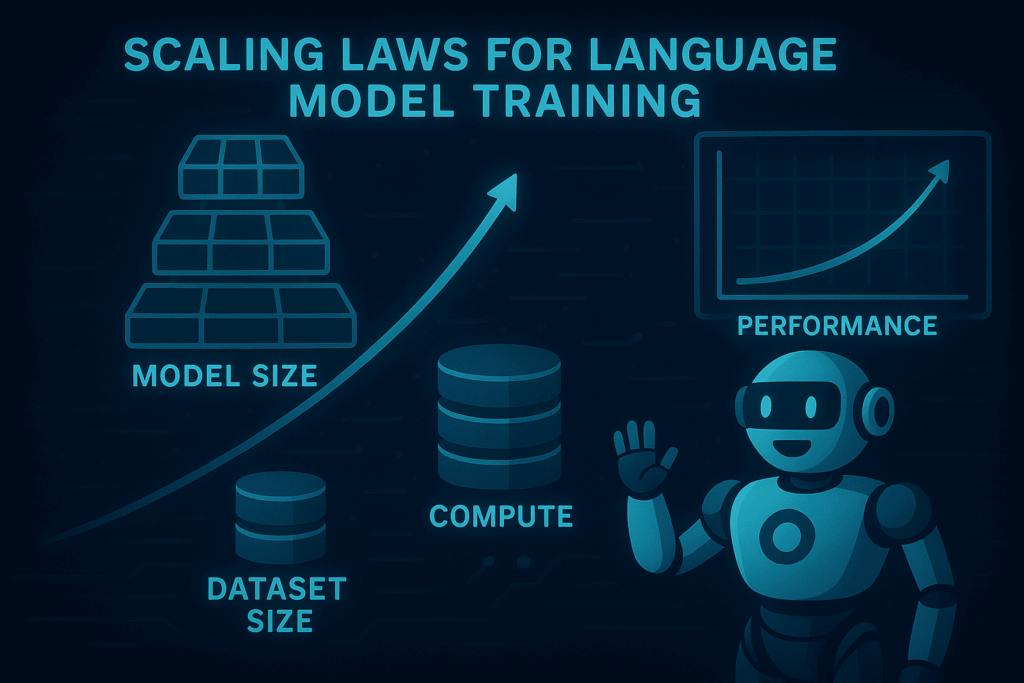
1. Introduction and Motivation
The paper addresses a fundamental question in AI: How should we allocate resources—model size, data, and compute—to train the most effective language models? By investigating the relationships between these factors, the authors aim to provide a practical guide for future model development.
Key Points:
- Scaling laws are empirical relationships that predict how model performance improves as resources increase.
- Understanding these laws helps avoid inefficient training (e.g., making a model too large for the available data).
- The study seeks to unify previous findings and extend them with new, comprehensive experiments.
2. Core Concepts and Definitions
To interpret the results, it’s important to understand the main variables:
- Model Size (N): Number of trainable parameters in the neural network.
- Dataset Size (D): Total number of tokens (words or subwords) in the training data.
- Compute Budget (C): Total computational effort, often measured in floating-point operations (FLOPs).
- Loss (L): Cross-entropy loss on validation data, indicating how well the model predicts unseen text.
Relationships Explored:
- How does increasing N, D, or C affect L?
- What’s the optimal way to balance these variables for best performance?
3. Experimental Setup
The authors designed a rigorous set of experiments:
- Model Architecture: Variants of the transformer model, scaled from small to very large.
- Training Data: Large, diverse text datasets to ensure generalizable results.
- Compute Range: From modest compute budgets (suitable for academic labs) to massive budgets (on par with industry-scale training).
- Evaluation: Consistent use of cross-entropy loss on a held-out validation set for fair comparison.
Why This Matters:
By systematically varying each factor, the study isolates the effects of model size, data, and compute, enabling robust conclusions.
4. Main Results: Detailed Scaling Laws
4.1. Loss vs. Model Size
- Finding: For a fixed dataset and compute, increasing model size reduces loss, following a power-law trend.
- Implication: Larger models are better—but the benefit shrinks as size increases (diminishing returns).
4.2. Loss vs. Dataset Size
- Finding: For a fixed model size, increasing the amount of training data also reduces loss, again following a power-law.
- Implication: More data is always helpful, but only up to a point—eventually, the model can’t make full use of extra data.
4.3. Compute-Optimal Allocation
- Key Formula: The paper derives mathematical expressions showing how to split your compute budget between making the model bigger and training it longer (on more data).
- Optimal Point: For any given compute budget, there’s a “sweet spot” where model size and dataset size are balanced for the best performance.
4.4. Unified Scaling Law
- Unified Model: The authors combine the above findings into a single law that predicts loss as a function of model size, data size, and compute.
- Accuracy: This unified law fits experimental data across a wide range of scales, making it a powerful tool for planning future training runs.
5. Practical Implications
For Researchers and Engineers
- Planning: Use scaling laws to estimate how much data and compute you’ll need for a target performance.
- Efficiency: Avoid waste—don’t train a huge model on a tiny dataset, or vice versa.
- Benchmarking: Compare new models or training strategies against the expected scaling curve.
For the AI Community
- Transparency: Scaling laws provide a common language for discussing model improvements.
- Progress: As models and datasets grow, scaling laws help track whether new methods are genuinely better or just bigger.
6. Limitations and Open Questions
- Architectural Scope: The study focuses on transformers; other architectures may scale differently.
- Data Quality: Assumes high-quality, diverse data; results may vary with noisy or domain-specific datasets.
- Task Specificity: Results are for language modeling; scaling for other tasks (e.g., reasoning, vision) may differ.
- Frontiers: How do scaling laws change for multimodal models (text + images) or for specialized domains?
7. Key Takeaways
- Performance improves predictably with more data, bigger models, and greater compute, but with diminishing returns.
- There’s an optimal allocation of resources for any compute budget—don’t just make models bigger; balance with data.
- Scaling laws are powerful tools for guiding AI research, benchmarking progress, and planning resource use.
Conclusion
This comprehensive study of scaling laws provides a roadmap for building and training future language models. By quantifying the trade-offs between model size, data, and compute, the paper empowers both researchers and practitioners to make informed, efficient decisions. As the field evolves, these insights will be crucial for pushing the boundaries of what language models can achieve.
Stay tuned for future posts where we’ll break down more cutting-edge papers and explore how these principles are shaping the next generation of AI!
Добавить комментарий